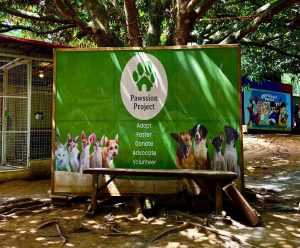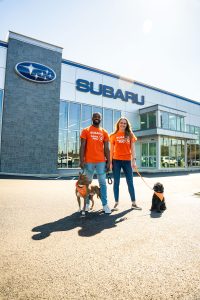I saw Garen, but he didn’t see me. Yet, he smiled still.
Garen is a dog, a totally blind dog. But he wasn’t blind before. A hit-and-run incident sometime during the pandemic did that to him. His eyeballs were dangling out of their sockets when he was rescued. And now he lives in total darkness. But that hasn’t dampened Garen’s cheerful personality.
Today, Garen senses the love of strangers all around. I don’t know if he’s aware of me approaching him, but he’s vigorously wagging his tail, and he looks like he’s smiling, tongue wagging. He must be sensing that a lot of us are coming towards him, wanting to pet him and give him back and neck rubs.
“We got the report about Garen three days after the accident. So it was very late to save his eyes,” Pawssion Project Foundation founder Malou Perez shares. “He’s blind, but he’s probably opened the eyes of more people than one can ever think of.”
Six-year-old Garen is one of two “ambassadogs” under the care of no-kill, non-profit animal rescue and shelter organization Pawssion Project Foundation.
Ten-year-old Lolo Paul, the other “ambassadog” that Malou brought with her, was lined up on “death row” at a pound in Old Balara town just as Malou and her group rescued him.
“Lolo Paul was one of the thousands of dogs in pounds all over the country waiting to die in vain because people don’t know that’s reality,” she says.
Lolo Paul, like Garen, seems to be born for the job with an always-ready smile. The two were with gregarious Malou and two of her staff when our group of 15 motoring media first met them inside the Mazda C5 Pasig dealership on July 15. The occasion was a partnership formed between Pawssion Project Foundation and Japanese car brand Mazda Philippines. The car company’s president and CEO Steven Tan turned over to Pawssion Project a Mazda BT-50 pickup truck specially equipped for animal rescues.
Mazda Philippines has been previously known for its efforts in raising awareness and the protection of the critically endangered Pangolin. For that advocacy, the car maker partnered with Palawan-based NGO Katala Foundation Inc in 2022 and issued two Pangolin Edition Mazda BT-50 pickup trucks to the organization for its rescue and patrol operations.

“I started the Pawssion Project Foundation almost 7 years ago in Bacolod where I was born and raised, and all because I saw a post on Facebook where there would be 50 to be killed by gunshot. It was not even by euthanasia. Prior to that, I didn’t know there were so many animal pounds in the Philippines. I didn’t know there were more than 12 million stray animals in the Philippines, and that gunshot was legal. I think it was really a catalyst for me,” Malou shares.
Today, we’re off to visit the Pawssion Project site in San Jose Del Monte, Bulacan, where over 300 other rescued dogs and cats are being sheltered, fed and cared for. Having just celebrated my birthday the day before, I felt this was a fitting post-birthday act, getting surrounded by four-legged friends who’ll make you feel that your visit has been the most important day, ever, in their lives.
At the Pawssion Project shelter, we are greeted by hundreds of barking, yelping dogs. Most of them are eager to approach us and see if we’ve brought any treats. All of them, like Garen, were rescued from pounds and from the streets. Some of them were abandoned by their humans. Like Garen, who, after being run over, was abandoned by his human family who said they couldn’t afford his treatments.
So many strays, too few shelters. It’s a growing problem, especially in this country where breeders are making a killing, and irresponsible fur parents abound. I can’t shout “Adopt, don’t shop!” loud enough.
The Universe works in mysterious ways, though. Malou’s passion is increasingly being echoed in the corporate boardrooms of the very companies whose products navigate the streets these animals often end up calling home.
Today was my second encounter with Malou and her group. The first was in 2023, when Honda Cars Philippines Inc (HCPI) facilitated a similar ride-and-drive to the shelter. Malou always had a mouthful to say about the state of care and compassion (or lack of them) our society has for its voiceless strays. Today was no different. She lamented that, despite the unconditional love our four-legged friends have constantly showered upon us, we give back emotional crumbs. Worse, we inflict harm upon them, thinking it’s a solution, but in truth only kindness is needed.
More car companies—here and around the world—are leaning towards animal rescues and animal protection. Just recently, Toyota Motor Philippines and TMP Foundation lent their long-term support for the Tamaraw Conservation Project of the Department of Environment and Natural Resources. HCPI, through its foundation, has also provided support for pawikan (sea turtle) conservation efforts.
Then there’s Subaru’s long-standing “Subaru Loves Pets” initiative. The program, in partnership with the American Society for the Prevention of Cruelty to Animals (ASPCA), has resulted in the adoption of hundreds of thousands of shelter animals. The campaign is a cornerstone of Subaru’s brand identity, resonating deeply with pet-loving consumers.
The movement, albeit subtle, now extends beyond charitable partnerships and into the manufacture of cruelty-free materials used in vehicle interiors. Volvo has taken a bold stance by committing to completely leather-free interiors in all its new fully electric cars, starting with the C40 Recharge. The Swedish automaker is actively developing and sourcing sustainable, bio-based, and recycled materials to replace animal-skin leather, citing animal welfare and the environmental impact of cattle farming as key motivators. This move is part of a larger industry-wide shift towards vegan-friendly interiors. Other major brands like Mercedes-Benz, BMW, and Ford now offer vehicles with high-quality, animal-free upholstery options.
Toyota also provides a synthetic leather alternative called “SofTex” in many of its models. Lexus uses non-animal leather called NuLuxe (also known as Tahara leather) in many of its vehicle models, while Porsche, Lamborghini, Maserati, Land Rover, and Alfa Romeo use Alcantara on some of their models. The all-electric Porsche Taycan has a vegan version with Race-Tex microfiber, a textile partly made from recycled polyester fibers.

Technological innovation is another front where car companies are making a difference. Nissan has developed the “Animalert” system, a novel application of its EV alert sound technology. This system emits a sound frequency designed to be heard by animals, such as deer, to help prevent them from wandering onto roadways and causing accidents. This proactive approach aims to safeguard wildlife and enhance road safety.
Previously, organizations like the People for the Ethical Treatment of Animals (PETA) had successfully lobbied automakers to end the use of animals in crash testing. Major companies like Ford, General Motors, and Stellantis have since banned this practice, marking a significant victory for animal rights in the automotive sector.
Seeing companies with global reach showing a big heart for the animals gives me hope that one day there will be no more animal parts being used for cars, and no more Garens and Lolo Pauls (and more Tamaraws, Pangolins and pawikans). And for that, I’m fully on board.










